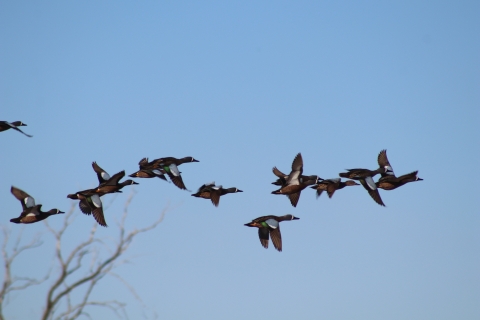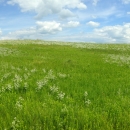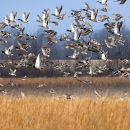What We Do
Wildlife conservation is at the heart of the National Wildlife Refuge System. It drives everything on U.S. Fish and Wildlife Service lands and waters managed within the Refuge System, from the purposes for which a national wildlife refuge national wildlife refuge
A national wildlife refuge is typically a contiguous area of land and water managed by the U.S. Fish and Wildlife Service for the conservation and, where appropriate, restoration of fish, wildlife and plant resources and their habitats for the benefit of present and future generations of Americans.
Learn more about national wildlife refuge is established to the recreational activities offered to the resource management tools used. Using conservation best practices, the Refuge System manages Service lands and waters to help ensure the survival of native wildlife species.
Management and Conservation
Refuges deploy a host of scientifically sound management tools to address biological challenges. These tools span active water management to wilderness character monitoring, all aimed at ensuring a balanced conservation approach to benefit both wildlife and people.
Our Services
Agricultural Opportunities on Waterfowl Production Areas (WPA)
All Bids Due COB Friday, February 21, 2025 to the office*
To download the map click here
Grazing
Lake Andes National Wildlife Refuge and Wetland Management District, Lake Andes, South Dakota has cooperative agriculture opportunities for grazing on Waterfowl Production Areas in Aurora, Brule, Charles Mix, Davison, Douglas, and Gregory counties for 2025, see list below. Bid forms may be obtained online with the link below or requested by calling the office at 605-546-8156. To be considered, applicants must complete and submit the bid form. Successful applicants will be selected through an open and competitive process. Winning bidders will be notified by February 28, 2025. For more information, please contact Liz Julian at 605-546-8156 or 605-481-9136 or by email at elizabeth_julian@fws.gov.
Aurora: Crystal Lake, Humphrey, Koch, Maine, Nielsen, Overweg, Schute, Sorenson, Stanley
Brule: Pipal
Charles Mix: Broken Arrow, Kafka, Koupal, Owens Bay, Raysby, Trout, Tucek, Van Zee, Varilek
Davison: Lindeman
Douglas: Broken Arrow, Coler, Denning, DeVelder, Huizenga, King, New Holland, Somek
Gregory: North Unit & South Unit Karl E. Mundt NWR
Farming
Lake Andes National Wildlife Refuge and Wetland Management District, Lake Andes, South Dakota has cooperative agricultural opportunities for farming 56.8 acres on Star WPA in Douglas County for 2025. Applicants must complete and submit a bid sheet with a price for total years of each unit. Successful applicants will be ranked using a competitive bidding process. Winning bidders will be notified by February 28, 2025. For more information, please contact the Refuge Manager 605-546-8156.
To download the Farming Bid Form click here
Haying
Lake Andes National Wildlife Refuge and Wetland Management District, Lake Andes, South Dakota has cooperative agriculture opportunities for haying 59.6 acres on Koss WPA in Brule County for 2025. To be considered, applicants must complete and submit the bid form. Successful applicants will be selected through an open and competitive process. Winning bidders will be notified by February 28, 2025. For more information, please contact the Refuge Manager 605-546-8156.
Our Projects and Research
Science sets the foundation for how fish, wildlife, plants and their habitats are managed at Lake Andes. In cooperation with other researchers, universities and science-based organizations we have created a broad-based platform in our ecological research to implement management strategies that are best suitable for entire landscapes and ecosystems, rather than a single species.
Laws and Regulations
Hunting and Fishing Rules and Regulations
Migratory game bird hunting – we allow migratory game bird hunting on designated areas of the refuge.
Upland game hunting – we allow upland game hunting on designated areas of the refuge.
Big game hunting – we allow upland game hunting on designated areas of the refuge.
Sport fishing – we allow sport fishing on designated areas of the refuge subject to the following condition: You must remove all boats, motor vehicles, fishing equipment, and other personal property, excluding ice houses, by the end of each day’s fishing activity.
Designated Areas (see map)
Owen’s Bay Unit – Hunting and fishing NOT allowed.
South Unit – Fishing allowed according to state regulations.
Center Unit – Hunting and fishing allowed according to state regulations.
North Unit – Closed to public access.
General Rules and Regulations
Hunting and Fishing are allowed in accordance with Federal regulations governing public use on national wildlife refuges as set forth in Title 50 of the Code of Federal Regulations, State regulations, and Refuge-specific regulations outlined in the Lake Andes National Wildlife Refuge Hunting and Fishing Regulations brochure.
Fishing
Fishing is allowed as per state regulations on the South and Center Units of Lake Andes. All boats, motor vehicles, fishing equipment, and other personal property, excluding ice houses, must be removed by the end of each day's fishing activity.
Hunting
Hunting in accordance with all state and federal regulations is permitted on the Center Unit of Lake Andes only. All boats, decoys, portable blinds, other personal property, and any materials brought onto the area for blind construction must be removed by the end of each day's hunt. Non-toxic shot is required for all shot shells.
Wildlife Observation
Wildlife observation and photography is allowed on the refuge in all areas open to the public.
Environmental education and interpretation
Environmental education and interpretation is allowed on the refuge in areas open to the public.
Parking
Parking is allowed in designated parking areas only. No overnight parking or camping is allowed.
Hiking
Foot travel is permitted on the Refuge. Hiking is allowed in all areas open to the public.
Bicycling
Bicycling is allowed only on designated public trails or roads.
Horses
Horseback riding is allowed on signed refuge public access routes that are open to motor vehicles.
Dogs
Dogs must be on a leash, unless participating in a hunting activity, and under control at all times.
Off-Road Vehicles
Use of any off-road vehicle, including those used on air, water, ice, snow, is prohibited except when used in association with an approved activity and that does not destroy, harm, or disturb habitat.
Boats
Use of motorized or non-motorized boats is allowed on the Center and South Units of the Lake. Loading and unloading of boats from the dike roads is not allowed.
Collection
Collecting of natural materials such as plants, animals, minerals, and artifacts are prohibited.
Firearms
Persons possessing, transporting, or carrying firearms on National Wildlife Refuge System lands must comply with all provisions of State and local law. Persons may only use (discharge) firearms in accordance with refuge regulations (50 CFR Part 27.42 and specific refuge regulations in 50 CFR Part 32).
Commercial Activities
Commercial activities are not allowed on the refuge.
Drones
Use of drones are not allowed on the refuge.
Other Activities
Consult with refuge staff about any activities not listed above.







